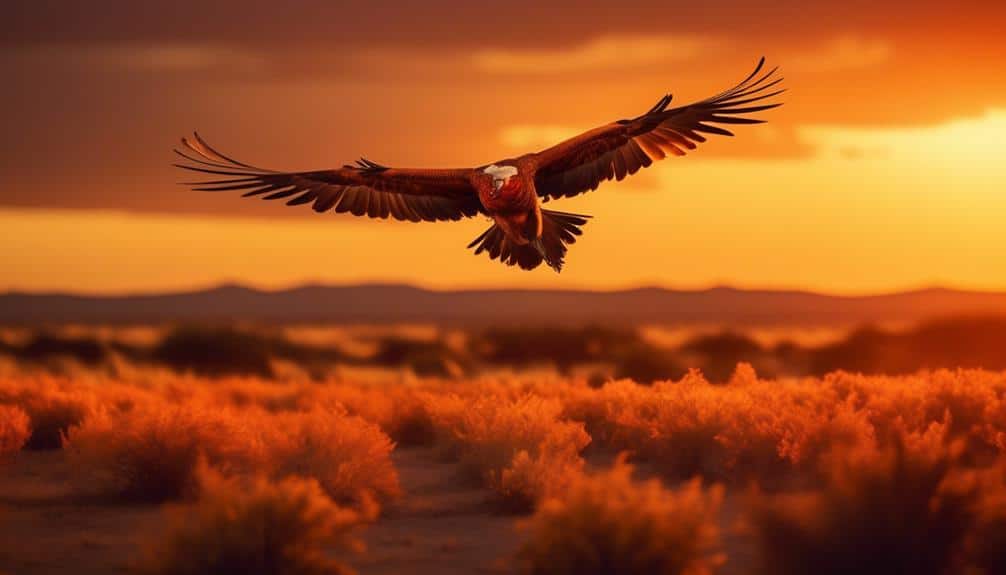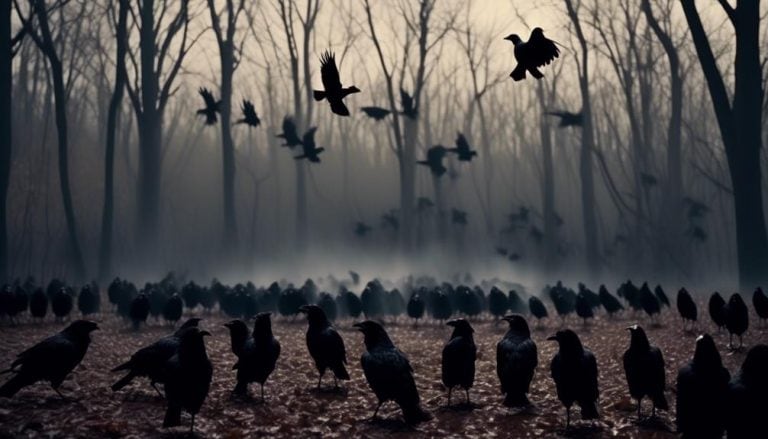Texas is home to various large bird species, such as the majestic Bald Eagles and the rare Whooping Cranes. These big birds captivate us with their size, beauty, and unique behaviors, making Texas a haven for bird enthusiasts.
As I stood in the vast expanse of the Texas prairie, a shadow quickly passed overhead, casting a momentary darkness on the sunlit landscape. It was as if a giant bird had spread its wings and soared above, its majestic presence leaving me in awe.
But there is so much more to discover about Big Birds in Texas and the secrets they hold within the vast landscapes of the Lone Star State.
Bald Eagles: The Majestic Raptors of Texas
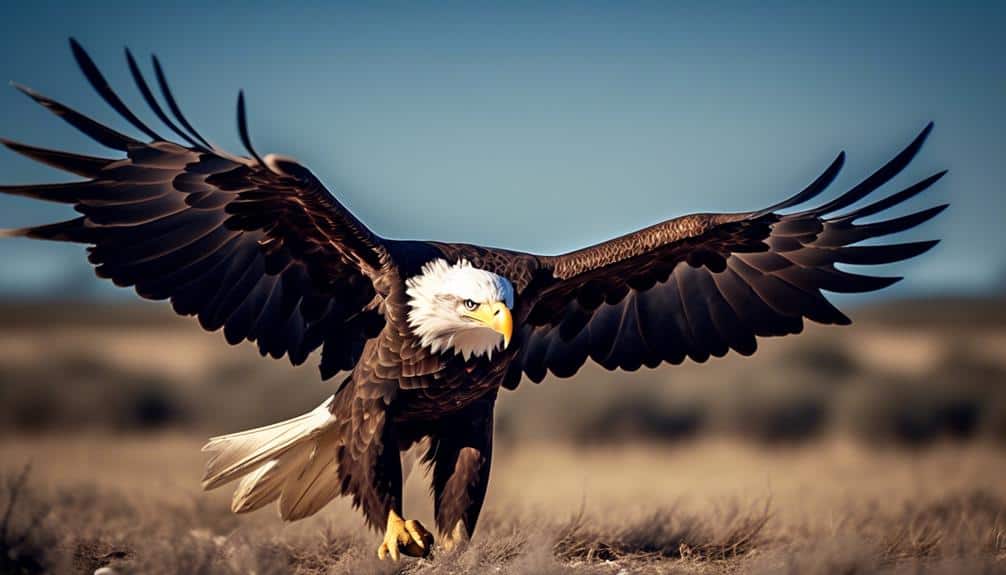
Bald Eagles, the majestic raptors of Texas, are awe-inspiring creatures prominent in the state’s diverse ecosystem. As a conservation biologist, I’ve studied these incredible birds and learned about their nesting habits. The conservation of bald eagles is paramount to ensure their continued presence in Texas.
Bald eagles are known for their large nests, which they build in tall trees near bodies of water. These nests, called eyries, are constructed with sticks and lined with softer grass and moss. The size of the eyrie can vary, with some reaching up to 10 feet in diameter. These nests are used year after year, with bald eagle pairs adding to them each breeding season.
Bald eagle nesting habits are fascinating. They’re monogamous birds, meaning they mate for life. Each breeding season, the pair engages in a courtship display involving elaborate aerial displays and vocalizations. Once the pair has bonded, they build and maintain their nest.
Conservation efforts for bald eagles in Texas have been successful in recent years. Banning harmful pesticides, such as DDT, has allowed the bald eagle population to recover. Additionally, the protection of nesting sites and habitat restoration projects have provided safe spaces for these magnificent birds to thrive.
Whooping Cranes: The Rare and Graceful Giants
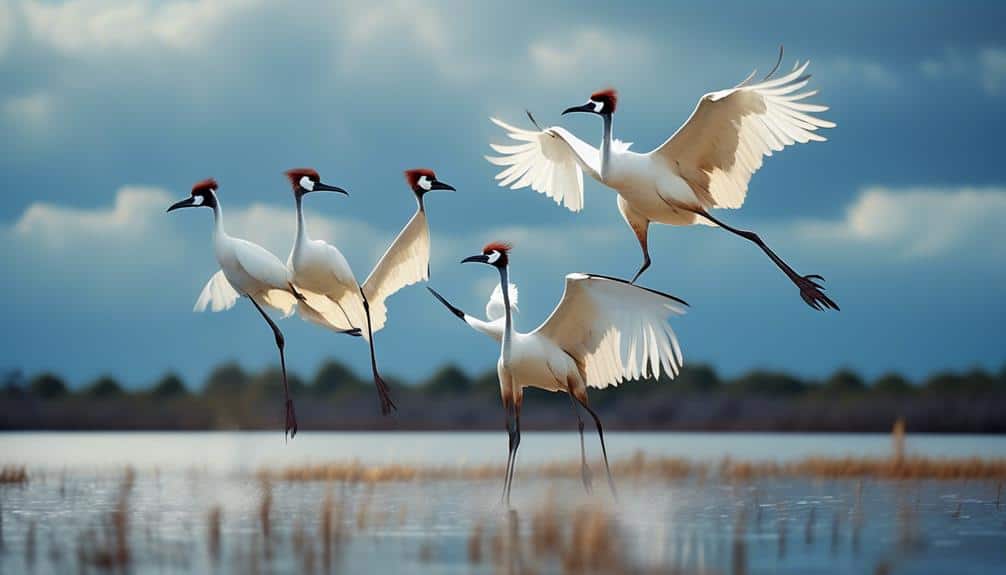
Whooping cranes, renowned for their rarity and gracefulness, capture the attention of scientists and nature enthusiasts alike with their majestic presence in the Texas ecosystem. These magnificent birds, standing at an impressive height of up to five feet, are an endangered species with a population of only around 500 individuals. Their striking appearance, with snowy white feathers contrasting against black wingtips and a vibrant red crown, makes them a sight to behold.
Conservation efforts have played a crucial role in protecting the whooping cranes and ensuring their survival. The International Crane Foundation, in collaboration with various organizations, has implemented measures to safeguard their habitats and promote breeding programs. These initiatives have helped increase the population of whooping cranes, but the species still faces numerous challenges.
To evoke a sense of emotion and highlight the urgency of conservation efforts, consider the following table:
| Challenges | Conservation Efforts | Impact |
|---|---|---|
| Loss of habitat | Habitat restoration and protection | Ensures suitable breeding grounds |
| Climate change | Research and monitoring | Helps mitigate adverse effects |
| Illegal hunting and disturbance | Strict regulations and enforcement | Reduces human-induced mortality |
| Vulnerability to disease and injury | Veterinary care and rehabilitation | Enhances survival rates |
Great Horned Owls: Silent Predators of the Night
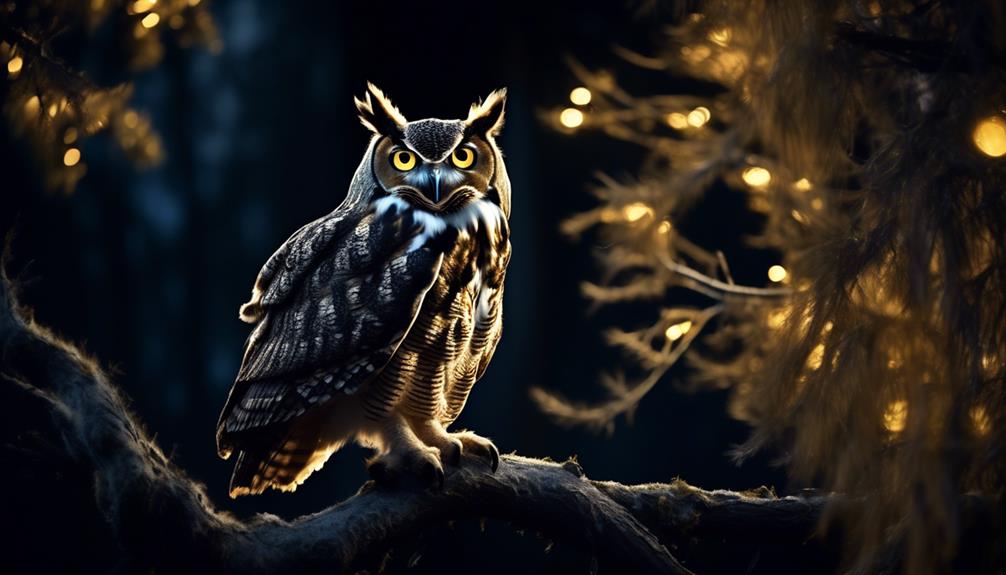
Great Horned Owls, known for their stealth and nocturnal hunting abilities, are formidable predators that dominate the night skies. These majestic birds possess silent hunting techniques, making them highly efficient nocturnal hunters.
One key aspect of the Great Horned Owls’ hunting strategy is their ability to fly silently. Their wings have serrated edges that reduce turbulence, allowing them to glide silently. This enables them to approach their prey undetected, giving them a significant advantage in capturing their target.
Another silent hunting technique employed by these owls is their incredibly sensitive hearing. They’ve large, forward-facing eyes that help them locate prey in low-light conditions. Their ears are asymmetrical, with one ear positioned higher than the other, allowing them to pinpoint the exact location of their prey based on sound. This remarkable auditory precision enables them to strike with deadly accuracy.
Great Horned Owls are opportunistic hunters and have a diverse diet. They prey on many animals, including rodents, birds, reptiles, and other owls. Their silent hunting techniques, powerful talons, and sharp beaks make them capable of taking down prey larger than themselves.
Sandhill Cranes: Texas’ Dancing and Migratory Birds
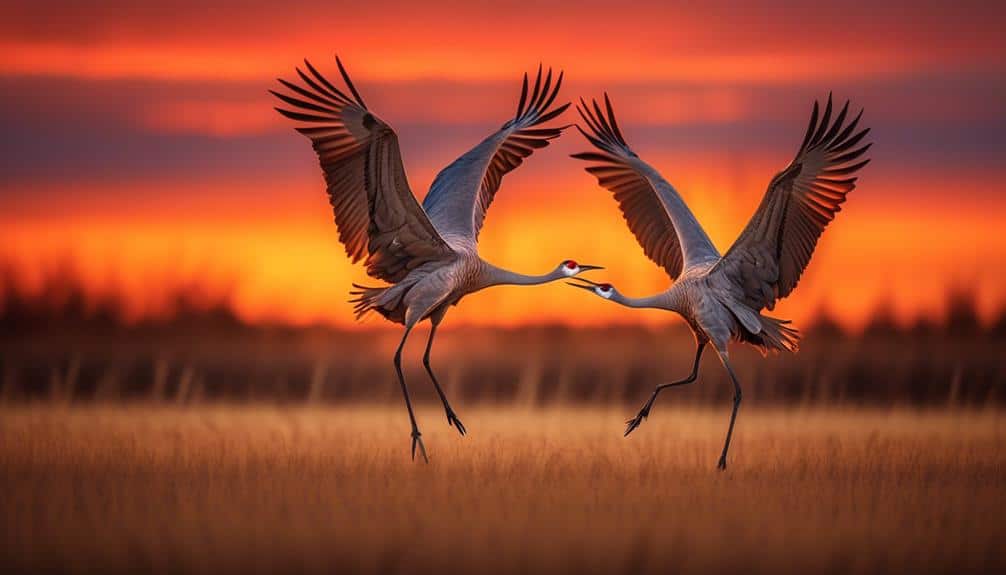
Sandhill Cranes, known for their graceful dancing and remarkable migratory patterns, are fascinating birds in Texas. These large, elegant birds are known for their elaborate mating rituals involving intricate dances and calls. During courtship, pairs of cranes engage in synchronized movements, leaping and bowing with extended wings. These displays not only serve to attract a mate but also strengthen the bond between partners.
Sandhill Cranes embark on an impressive migration across North America as winter approaches. Texas plays a crucial role in their journey, as it is a significant stopover site for these majestic birds. Every year, thousands of Sandhill Cranes descend upon the wetlands and prairies of Texas, seeking food and rest before continuing their journey south.
The winter migration of Sandhill Cranes is a sight to behold. Flying in large V-shaped formations, these birds cover vast distances, sometimes traveling over 500 miles daily. Their distinctive calls echo through the sky as they navigate the changing landscapes.
In Texas, the Aransas National Wildlife Refuge serves as a vital wintering ground for Sandhill Cranes, providing them with the necessary resources to survive the harsh winter months. The refuge’s extensive marshes and prairies offer abundant food sources, including grains, insects, and small vertebrates.
Witnessing the dancing displays and observing the migratory patterns of Sandhill Cranes in Texas is a truly remarkable experience. These birds are a testament to the wonders of nature and the importance of conserving their habitats for future generations to enjoy.
Roseate Spoonbills: The Pink Beauties of Texas Wetlands

The wetlands of Texas are home to a striking bird species known as the Roseate Spoonbill, with its vibrant pink plumage and unique feeding habits. Roseate spoonbills are a sight to behold, standing around 2.5 feet tall with a wingspan of up to 4.5 feet. Their pink feathers, which range from pale pink to deep rose, result from their diet, which is rich in small crustaceans, such as shrimp and crayfish. These birds have a distinctively shaped bill, which is long and spoon-shaped, allowing them to sift through the water and mud for their prey.
Roseate spoonbills are known for their communal feeding behavior. They often gather in large flocks and wade through shallow water, using their sensitive bills to detect prey. Once a suitable prey item is detected, they quickly snap their bills shut, capturing it. This unique feeding method sets them apart from other wading birds found in the wetlands.
Conservation efforts have been crucial in maintaining the population of roseate spoonbills in Texas. Due to habitat loss and hunting, their numbers declined significantly in the past. However, their population has rebounded with the establishment of protected areas and conservation programs. Today, roseate spoonbills are considered a conservation success story, with their numbers steadily increasing.
To ensure the continued survival of these pink beauties, ongoing efforts are focused on protecting their wetland habitats, minimizing disturbance during nesting season, and monitoring population trends. By understanding their unique feeding habits and implementing conservation measures, we can ensure the longevity of these magnificent birds in the Texas wetlands.
Greater Roadrunners: Fast and Curious Birds of the Lone Star State
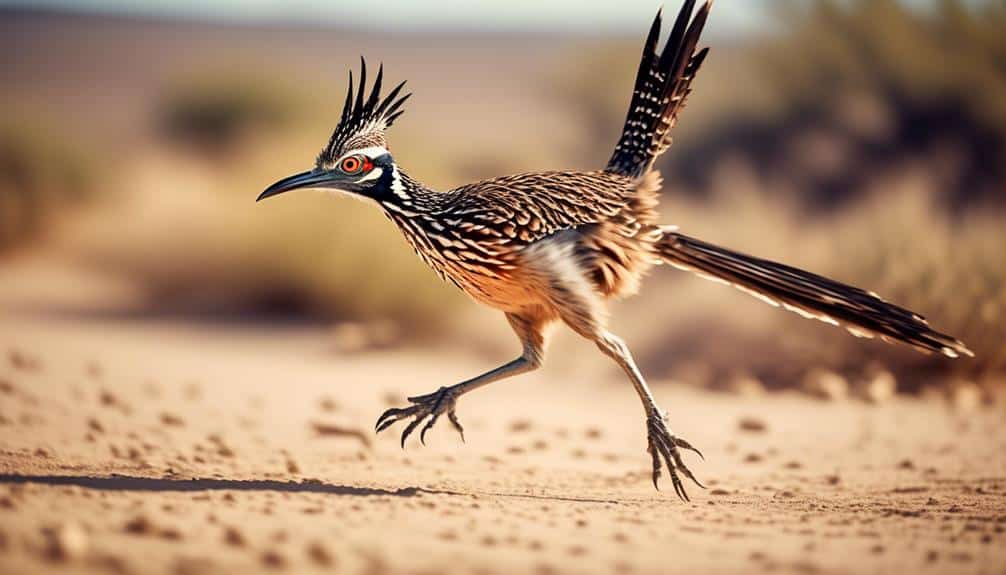
After exploring the graceful beauty of the Roseate Spoonbills in the Texas wetlands, we now turn our attention to the intriguing Greater Roadrunners, fast and curious birds that roam the Lone Star State.
- Speed and Agility:
Greater Roadrunners are renowned for their incredible speed and agility. With a top speed of 20 miles per hour, they can outrun most predators, including snakes and coyotes. Witnessing these birds sprint across the open grasslands is a breathtaking sight.
2. Inquisitive Nature:
Greater Roadrunners are known for their curious behavior. They have a knack for investigating their surroundings and often stop to examine interesting objects or prey. Their inquisitiveness adds to their charm and makes them a joy to observe in the wild.
3. Habitat Adaptation:
Roadrunners are highly adaptable birds, capable of thriving in various habitats. In Texas, they can be found in arid regions, brushlands, and even suburban areas. They prefer open spaces with scattered vegetation, as they provide cover for hunting and nesting.
These fascinating birds aren’t only fast and nimble and keenly curious about their surroundings. Their ability to adapt to different habitats allows them to flourish in the diverse landscapes of Texas.
Frequently Asked Questions
What Is the Average Wingspan of a Bald Eagle in Texas?
The average wingspan of a bald eagle in Texas is approximately 6 to 7.5 feet. These majestic birds are known for their impressive size and strength and prefer nesting in tall trees near bodies of water.
How Many Breeding Pairs of Whooping Cranes Are Currently in Texas?
As a birder, I’m thrilled to report that Texas is home to many breeding pairs of whooping cranes. Thanks to successful conservation efforts, their population is steadily increasing.
What Is the Primary Diet of Great Horned Owls in Texas?
The primary diet of great horned owls in Texas consists of small mammals, birds, and reptiles. They are opportunistic predators and can even take down prey larger than themselves. Their hunting prowess is impressive.
How Far Do Sandhill Cranes Typically Migrate During Their Annual Migration in Texas?
Sandhill cranes typically migrate long distances during their annual migration in Texas. Their migration patterns span hundreds of miles, depending on their breeding grounds and wintering areas. The population of sandhill cranes in Texas varies throughout the year.
What is the significance of the pink plume of roseate spoonbills in Texas wetlands?
The pink plumage of roseate spoonbills in Texas wetlands is a captivating symbol of the beauty and importance of these ecosystems. Their vibrant color attracts attention, raising awareness for wetland conservation efforts.
Conclusion
In conclusion, the diverse bird species found in Texas, such as the Bald Eagles, Whooping Cranes, Great Horned Owls, Sandhill Cranes, Roseate Spoonbills, and Greater Roadrunners, showcase the state’s rich wildlife.
Despite the potential objection that birdwatching may seem mundane or unexciting, exploring the world of these majestic creatures reveals a whole new level of beauty and fascination.
By immersing ourselves in the scientific and informative study of these big birds, we can truly appreciate the wonders of nature around us.

